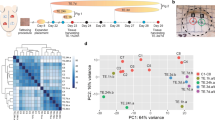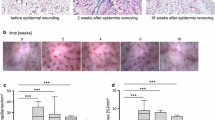Abstract
In adults, severely damaged skin heals by scar formation and cannot regenerate to the original skin structure. However, tissue expansion is an exception, as normal skin regenerates under the mechanical stretch resulting from tissue expansion. This technique has been used clinically for defect repair and organ reconstruction for decades. However, the phenomenon of adult skin regeneration during tissue expansion has caused little attention, and the mechanism of skin regeneration during tissue expansion has not been fully understood. In this study, microarray analysis was performed on expanded human skin and normal human skin. Significant difference was observed in 77 genes, which suggest a network of several integrated cascades, including cytokines, extracellular, cytoskeletal, transmembrane molecular systems, ion or ion channels, protein kinases and transcriptional systems, is involved in the skin regeneration during expansion. Among these, the significant expression of some regeneration related genes, such as HOXA5, HOXB2 and AP1, was the first report in tissue expansion. Data in this study suggest a list of candidate genes, which may help to elucidate the fundamental mechanism of skin regeneration during tissue expansion and which may have implications for postnatal skin regeneration and therapeutic interventions in wound healing.




Similar content being viewed by others
References
Austad ED, Pasyk KA, McClatchey KD, Cherry GW (1982) Histomorphologic evaluation of guinea pig skin and soft tissue after controlled tissue expansion. Plast Reconstr Surg 70:704–710
Austad ED, Thomas SB, Pasyk K (1986) Tissue expansion: dividend or loan? Plast Reconstr Surg 78:63–67
Benjamini Y, Hochberg Y (1995) Controlling the false discovery rate: a practical and powerful approach to multiple testing. J R Statist Soc 57:289–300
Boncela J, Przygodzka P, Papiewska-Pajak I, Wyroba E, Osinska M, Cierniewski CS (2010) Plasminogen activator inhibitor type 1 interacts with {alpha}3 subunit of proteasome and modulates its activity. J Biol Chem [Epub ahead of print]
Cantile M, Schiavo G, Terracciano L, Cillo C (2008) Homeobox genes in normal and abnormal vasculogenesis. Nutr Metab Cardiovasc Dis 18:651–658
Caré A, Silvani A, Meccia E, Mattia G, Stoppacciaro A, Parmiani G, Peschle C, Colombo MP (1996) HOXB7 constitutively activates basic fibroblast growth factor in melanomas. Mol Cell Biol 16:4842–4851
Cherry GW, Austad E, Pasyk K, McClatchey K, Rohrich RJ (1983) Increased survival and vascularity of random-pattern skin flaps elevated in controlled expanded skin. Plast Reconstr Surg 72:680–687
De Filippo RE, Atala A (2002) Stretch and growth: the molecular and physiologic influences of tissue expansion. Plast Reconstr Surg 109:2450–2462
Duboule D (1995) Vertebrate HOX genes and proliferation: an alternative pathway to homeosis? Curr Opin Genet Dev 5:525–528
Dudas M, Wysocki A, Gelpi B, Tuan TL (2008) Memory encoded throughout our bodies: molecular and cellular basis of tissue regeneration. Pediatr Res 63:502–512
Freyhult E, Landfors M, Önskog J, Hvidsten TR, Rydén P (2010) Challenges in microarray class discovery: a comprehensive examination of normalization, gene selection and clustering. BMC Bioinformatics 11:503
Fukui Y, Masuda H, Takagi M, Takahashi K, Kiyokane K (1997) The presence of h2-calponin in human keratinocyte. J Dermatol Sci 14:29–36
Fumagalli M, Musso T, Vermi W, Scutera S, Daniele R, Alotto D, Cambieri I, Ostorero A, Gentili F, Caposio P et al (2007) Imbalance between activin A and follistatin drives postburn hypertrophic scar formation in human skin. Exp Dermatol 16:600–610
Garin E, Lemieux M, Coulombe Y, Robinson GW, Jeannotte L (2006) Stromal Hoxa5 function controls the growth and differentiation of mammary alveolar epithelium. Dev Dyn 235:1858–1871
Gumbiner BM (1996) Cell adhesion: the molecular basis of tissue architecture and morphogenesis. Cell 84:345–357
Huang S, Ingber DE (1999) The structural and mechanical complexity of cell-growth control. Nat Cell Biol 1:E131–E138
Ingber DE, Dike L, Hansen L, Karp S, Liley H, Maniotis A, McNamee H, Mooney D, Plopper G, Sims J et al (1994) Cellular tensegrity: exploring how mechanical changes in the cytoskeleton regulate cell growth, migration, and tissue pattern during morphogenesis. Int Rev Cytol 150:173–224
Jain K, Sykes V, Kordula T, Lanning D (2008) Homeobox genes Hoxd3 and Hoxd8 are differentially expressed in fetal mouse excisional wounds. J Surg Res 148:45–48
Johnson PE, Kernahan DA, Bauer BS (1988) Dermal and epidermal response to soft-tissue expansion in the pig. Plast Reconstr Surg 81:390–397
Kömüves LG, Michael E, Arbeit JM, Ma XK, Kwong A, Stelnicki E, Rozenfeld S, Morimune M, Yu QC, Largman C (2002) HOXB4 homeodomain protein is expressed in developing epidermis and skin disorders and modulates keratinocyte proliferation. Dev Dyn 224:58–68
Kumar S, Duester G (2010) Retinoic acid signaling in perioptic mesenchyme represses Wnt signaling via induction of Pitx2 and Dkk2. Dev Biol 340:67–74
La Celle PT, Polakowska RR (2001) Human homeobox HOXA7 regulates keratinocyte transglutaminase type 1 and inhibits differentiation. J Biol Chem 276:32844–32853
Lin Z, Ma H, Nei M (2008) Ultraconserved coding regions outside the homeobox of mammalian Hox genes. BMC Evol Biol 8:260
Mack JA, Abramson SR, Ben Y, Coffin JC, Rothrock JK, Maytin EV, Hascall VC, Largman C, Stelnicki EJ (2003) Hoxb13 knockout adult skin exhibits high levels of hyaluronan and enhanced wound healing. Faseb J 17:1352–1354
Martin P (1997) Wound healing—Aiming for perfect skin regeneration. Science 276:75–81
Matturri L, Azzolini A, Riberti C, Lavezzi AM, Cavalca D, Vercesi F, Azzolini C (1992) Long-term histopathologic evaluation of human expanded skin. Plast Reconstr Surg 90:636–642
Metcalfe AD, Ferguson MW (2005) Harnessing wound healing and regeneration for tissue engineering. Biochem Soc Trans 33:413–417
Neumann CG (1946) The expansion of an area of skin by progressive distention of a subcutaneous balloon; use of the method for securing skin for subtotal reconstruction of the ear. Plast Reconstr Surg 19:124–130
Papa S, Zazzeroni F, Fu YX, Bubici C, Alvarez K, Dean K, Christiansen PA, Anders RA, Franzoso G (2008) Gadd45beta promotes hepatocyte survival during liver regeneration in mice by modulating JNK signaling. J Clin Invest 118:1911–1923
Park JM, Adam RM, Peters CA, Guthrie PD, Sun Z, Klagsbrun M, Freeman MR (1999) AP-1 mediates stretch-induced expression of HB-EGF in bladder smooth muscle cells. Am J Physiol 277:C294–C301
Ruoslahti E (1997) Stretching is good for a cell. Science 276:1345–1346
Stasinopoulos IA, Mironchik Y, Raman A, Wildes F, Winnard P Jr, Raman V (2005) HOXA5-twist interaction alters p53 homeostasis in breast cancer cells. J Biol Chem 280:2294–2299
Stelnicki EJ, Kömüves LG, Kwong AO, Holmes D, Klein P, Rozenfeld S, Lawrence HJ, Adzick NS, Harrison M, Largman C (1998) HOX homeobox genes exhibit spatial and temporal changes in expression during human skin development. J Invest Dermatol 110:110–115
Takei T, Han O, Ikeda M, Male P, Mills I, Sumpio BE (1997) Cyclic strain stimulates isoform-specific PKC activation and translocation in cultured human keratinocytes. J Cell Biochem 67:327–337
Thummel R, Ju M, Sarras MP Jr, Godwin AR (2007) Both Hoxc13 orthologs are functionally important for zebrafish tail fin regeneration. Dev Genes Evol 217:413–420
Timmenga EJ, Das PK (1992) Histomorphological observations on dermal repair in expanded rabbit skin: a preliminary report. Br J Plast Surg 45:503–507
Vandenburgh HH (1992) Mechanical forces and their second messengers in stimulating cell growth in vitro. Am J Physiol 262:R350–R355
Wan H, Dingle S, Xu Y, Besnard V, Kaestner KH, Ang SL, Wert S, Stahlman MT, Whitsett JA (2005) Compensatory roles of Foxa1 and Foxa2 during lung morphogenesis. J Biol Chem 280:13809–13816
Wollina U, Berger U, Stolle C, Stolle H, Schubert H, Zieger M, Hipler C, Schumann D (1992) Tissue expansion in pig skin: a histochemical approach. Anat Histol Embryol 21:101–111
Workman C, Jensen LJ, Jarmer H, Berka R, Gautier L, Nielser HB, Saxild HH, Nielsen C, Brunak S, Knudsen S (2002) A new non-linear normalization method for reducing variability in DNA microarray experiments. Genome Biol 3:research0048
Yoshimi T, Nakamura N, Shimada S, Iguchi K, Hashimoto F, Mochitate K, Takahashi Y, Miura T (2005) Homeobox B3, FoxA1 and FoxA2 interactions in epithelial lung cell differentiation of the multipotent M3E3/C3 cell line. Eur J Cell Biol 84:555–566
Acknowledgments
We thank Dr Da Zhou for his help in sample collection and Kara Spiller for the modification of this manuscript. Key Project of National Natural Science Foundation NO. 30730092.
Conflict of interest
The authors have declared that no conflict of interest exists.
Author information
Authors and Affiliations
Corresponding author
Additional information
M. Yang and Y. Liang contributed equally to this study.
Rights and permissions
About this article
Cite this article
Yang, M., Liang, Y., Sheng, L. et al. A preliminary study of differentially expressed genes in expanded skin and normal skin: implications for adult skin regeneration. Arch Dermatol Res 303, 125–133 (2011). https://doi.org/10.1007/s00403-011-1123-2
Received:
Revised:
Accepted:
Published:
Issue Date:
DOI: https://doi.org/10.1007/s00403-011-1123-2




